Film Name: 茶啊二中 / Oh My School!
“Oh My School! “stands out somewhat as it lands in current theaters.
Setting aside children’s animation, the domestic animated films we’ve seen in recent years have mostly been fantasy blockbusters. Even Chang An, which touches more on reality, requires immense imagination to connect scenes and control the narrative. It’s fair to say we’ve grown accustomed to seeing exotic lands and hearing fantastical sounds in these animations, judging their quality by the abundance and intensity of such elements.
But “Oh My School!” takes a different path. Beyond its surreal premise of teacher-student role reversal and occasional fantasy sequences, everything else is grounded in reality—perhaps too realistically. It mirrors the story’s setting in Changchun, specific locations like Northeast Normal University Affiliated High School and Nanhu Park, and resonates deeply with the shared experiences of middle school life.
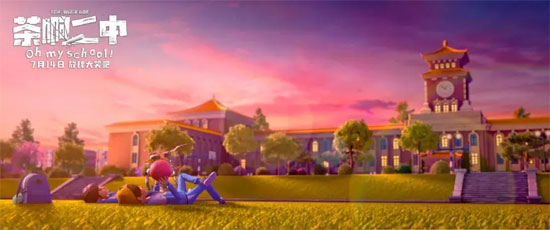
Changchun was historically known as “Cha A Chong,” an ancient Suishun ritual blessing for heavenly blessings. The creators deconstructed this into “Cha A No. 2 Middle School,” explicitly marking its origin and lineage.
“Oh My School!” is firmly anchored in Class 3 of Grade 9 at this fictional high school—a so-called “troubled students” class. Their homeroom teacher, Shi Miaona, is fiery and intimidating. As for the diverse students, led by Wang Qiang, each stirs up their own trouble. The story’s conflicts and the plot driven by these clashes deliver a series of recognizable moments from middle school days.
It’s been a long time since we’ve seen such a subject in animation, yet this should be the most commonplace kind—drawing from the surroundings, from memories, from the ever-repeating present—to achieve a tacit resonance with the audience. It requires no prior knowledge and sets no barriers.
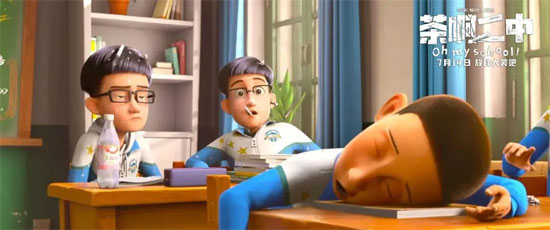
On one hand, it diverges from the crowded direction of animated films; on the other, it remedies the stiffness, vulgarity, and tedium often found in live-action adaptations of campus stories and comedies. Though an anomaly, it achieves a roundabout success.
Another distinctive feature of this film is its relatively thorough simplification of the increasingly audience-unfriendly animation style prevalent in recent years. The visuals aren’t overly polished or intricate, the runtime doesn’t exceed the classic one-and-a-half-hour mark, and its narrative thread is streamlined to the mutual understanding between teacher and student. It relies solely on the main storyline of their journey from mutual dislike to understanding to drive the narrative forward and release emotional tension.
One could argue that “Oh My School!” first reveals a distinct facet of contemporary Chinese animation—not that films can be made this way, but that they could have been made this way all along, yet we’ve long forgotten it.
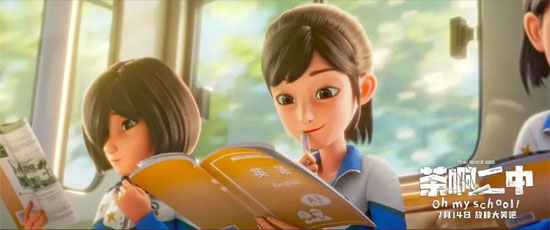
Even though it’s entirely set in a Northeastern context—with its linguistic habits, lifestyle, and social dynamics steeped in regional flavor—anyone can effortlessly immerse themselves in it.
Watching this film by chance, one discovers precisely this kind of delightful surprise.
It compels us to trace back to the most fundamental, unadorned commonality that sustains animation—or storytelling itself. Crucially, “Oh My School!” embraces traditional conventions while consciously aligning itself with the most clichéd tropes.
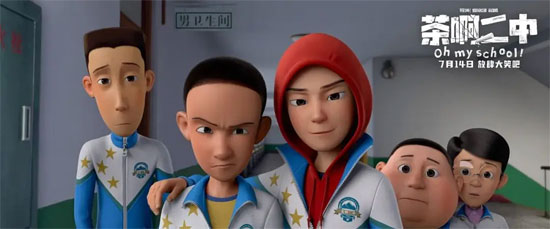
Take “body swap” plots, for instance—we can easily name a slew of films like Dating the Enemy, The Change-Up, Your Name. “Daddy You, Daughter Me.” In recent years, China’s representative entry is “Never Say Die.” Frankly, this premise has been overused, especially after being heavily processed by Happy Mahua’s big-budget productions. Moreover, this formula often becomes a quick-fix dramatic device for mutual understanding, limiting the narrative’s direction.
“Oh My School!” chooses to perform on this very high stage, which carries an inherent narrative risk: it’s difficult to avoid repeatedly piling on stereotypes.
In the film, teachers are portrayed as violent and tyrannical, while students are rebellious and disrespectful. The dynamic of the evil teacher versus the bad student is a well-worn trope in campus dramas. It’s not hard to predict that the story will inevitably lead to mutual understanding and mutual fulfillment between teachers and students.
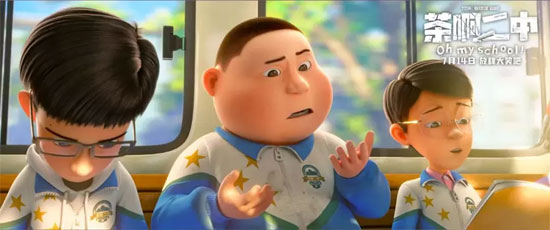
Indeed, this is precisely how it unfolds. Given audience expectations and market trends, it seems the film had little choice but to follow this path. This inevitability seals its fate as a textbook-rigid approach, condemning “Oh My School!” to an exceptionally arduous journey in its big-screen debut.
Undeniably, stripping away complexity to innovate is far more challenging than adding layers of embellishment. It must be said, this film possesses the audacity to venture into dangerous territory.
Thus, what struck me most profoundly was how masterfully it subverts conventions to fill the void.
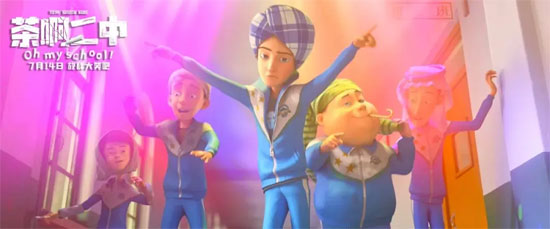
The aforementioned approach of making the old new—presenting a distinct stance from contemporary animations—is one form of subversion. Yet when it comes to details, the film also boasts numerous bold and confident experiments.
This film lays all its cards on the table. The main plot and its trajectory are clear to everyone. Yet for audiences—especially those new to this IP—it’s hard to imagine that such an old tree could sprout so many unexpected new branches.
The teacher-student chase echoes “Tom and Jerry,” layering the relationship with a “demonized” imagination. Of course, the literal “demonization” depicted here leans more neutral—it’s about unleashing imagination. Through exaggerated animation, it offers a psychological defense mechanism for audiences to counter unequal power dynamics during their student days. It may not be as straightforward or fierce as it appears on the surface, but it often carries a self-satisfied pride that quickly bridges the gap.
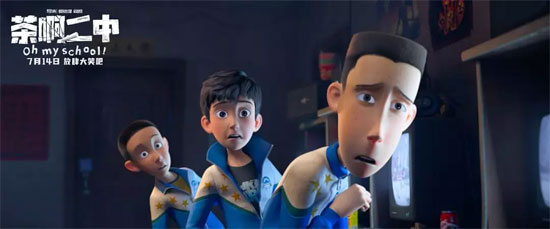
This dynamic also gives rise to the film’s playful treatment of harsh realities—or rather, its use of humor to lighten the heavy atmosphere. When Wang Qiang and others sneak off to the internet cafe only to be “hunted down” by Teacher Shi, the class preemptively holds a mock memorial service called the “Catch-Up Ceremony.” This irreverent mourning reinforces Teacher Shi’s stern and formidable persona while amplifying the students’ resigned self-deprecation.
The gags are wildly imaginative, yet they transcend mere humor. After mutual understanding and affection between teacher and students reached its peak, the students organized a “gathering” for Teacher Shi.
Just when many assumed the students had become well-behaved and the teacher would finally soften, a class-signed certificate appeared. It expressed acceptance and affection, playfully warning her, “Don’t get too proud.” Typically, at this point, the emotional atmosphere peaks, tears flow, and the story concludes perfectly.
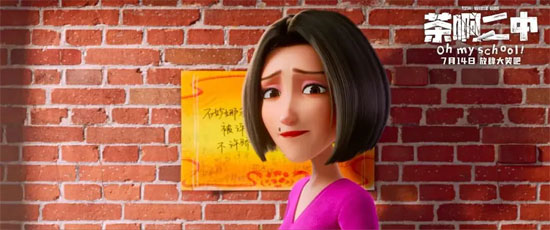
But not “Oh My School!”—Mr. Shi’s sudden outburst of temper abruptly pulled everyone back to reality. Only the knowing smiles exchanged between them hinted at future conflicts, yet assured a bright and sunny future.
Such contrasts abound, and it’s precisely these casual plot twists and reversals that raise the bar for artistic daring.
Throughout this process, the distinctive Northeast Chinese dialect inevitably lends its unique flavor.
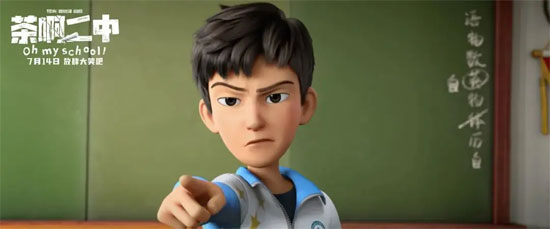
The use of dialects in animated series is actually quite uncommon. Back in the day, although Bu Si Fan’s “Dahufa” heavily promoted its Cantonese version, a Mandarin version was also produced. “Oh My School!” also considered a Mandarin adaptation, but a story so closely tied to Changchun would inevitably lose its luster without the dialect’s authentic touch.
Beyond its broad appeal, even someone like me from Cantonese-speaking regions can instantly grasp the sharp wit and humor in this dialect. Ultimately, it’s deeply tied to local culture—or rather, the spirit and character of the region.
Beneath that boisterous, brash exterior lies an innate, unforced cheerfulness—a blend of recklessness and silliness. Yet life’s sorrows are absorbed into this very fabric, smoothly transformed into a kind of wisdom, much like the film’s style or even its very spirit. Without this language, many things couldn’t sweep by like the wind; they’d just lie heavy on the ground, exposing their utterly boring bones.

Audiences would also struggle to feel the warm heart hidden beneath the rapid-fire banter, ready to make you laugh or cry at any moment.
Even if this film claims to evoke collective nostalgia, its story is clearly confined to the youth of only a segment of people. Yet the Northeastern dialect, with its inherent emotional resonance, manages to weave a coarse yet warmly affectionate tapestry. Through this, much like the film’s exaggerated techniques, it amplifies the audience’s fond recollections of that era—even if those memories are filtered and refined.
In other words, rather than demanding universal resonance from nostalgic templates, collective emotional resonance is more akin to a fermentation process—or its end product. It’s not sorrow, fear, or rage that deserve remembrance and celebration, but rather how these negative elements, distanced by time, contextualized by others, and translated through comedic exaggeration, can be refined into something beautiful.

“Oh My School!” accomplishes precisely this task, using the simplest of school-based, passionate, inspirational tropes to construct an unburdened comedy. There’s a comforting feeling inherent in this approach.
So there’s no need—nor any possibility—of hyping “Oh My School!” into a masterpiece. It doesn’t seek to be elevated to a false pedestal. Even as it nervously makes its way to the big screen, its inherent sincerity remains undiminished by its own trepidation.
That sincerity—unmasked by design, compromise, or expectation—earns the audience’s affection and admiration for the grassroots team behind it. They’re content to stay rooted in their hometown, crafting stories deeply connected to their lives, fearing that leaving their roots would mean losing both their foundation and their authenticity.

This IP, launched in 2014, began as a best-effort yet inevitably rough instant noodle-style series, interspersed with fleeting flashes of brilliance. Its journey to this point relies on emotional resonance and, crucially, an integrity that remains uncorrupted. Achieving a breakthrough in feature film format—regardless of box office performance or production shortcomings—at least honors the youth of many who supported it.
This isn’t to say we shouldn’t demand higher quality—that remains their rightful goal for future projects—but when such a relatively modest yet innovative work enters the market, it should offer us insights into scale, subject matter, breakthroughs, and diversity. That value far outweighs nitpicking over every flaw.
Please specify:Anime Phone Cases » Oh My School! 2023 Film Review: Long time no see, carefree animation